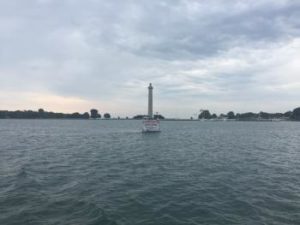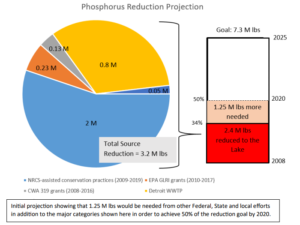Blog
Tagged In: Clean Water, Environmental Health, Great Lakes, Lake Erie, Water Pollution
Curbing Toxic Algae – A Missed Opportunity
Kristy Meyer, August 29, 2017
 This week, Ohio released a draft of its latest plan to tackle Lake Erie’s toxic algae. The long awaited plan details Ohio’s role in the binational agreement between Great Lakes states and province to reduce algae-causing pollution by 40% by 2025.
This week, Ohio released a draft of its latest plan to tackle Lake Erie’s toxic algae. The long awaited plan details Ohio’s role in the binational agreement between Great Lakes states and province to reduce algae-causing pollution by 40% by 2025.
Ohio’s plan includes some concrete steps for reducing the phosphorus pollution that feeds toxic algae. These steps include wetland restoration, increased monitoring of septic systems, and rules to address the public health impacts of manure runoff in streams and rivers. Unfortunately, according to the best and most recent scientific analysis, these measures fall drastically short of what is really needed to get to the 40% reduction.
The glaring hole in the plan is that the Ohio Department of Agriculture is not proposing legislation, or establishing new rules to curb pollution from mega-farms and livestock operations. Rather it will work to promote the same voluntary adoption of conservation practices through existing programs, and by establishing a new Farm Stewardship Certification for farmers.
Sign our petition to tackle toxic algae!
While the agency will continue to administer laws currently on the books, such as the Clean Lake Erie Act, ensuring large agricultural operations aren’t responsible for excessive fertilizer and manure pollution rests squarely on citizens. No one is going to do anything about the massive hog operation down the street improperly spreading manure unless a local speaks up, which assumes we all know how to even file a complaint in the first place.
We need proactive solutions to address phosphorus pollution. The Ohio plan is a missed opportunity to pursue those concrete solutions that Lake Erie communities and businesses need. Every year delayed is another year that our neighbors up North have to hold their breath, wondering if they will lose their drinking water.
It’s not just the OEC’s opinion that the current plan isn’t enough. The U.S. EPA evaluated the collective actions proposed by each state and the prognosis is not good. The federal agency determined an additional 1.25 million pounds of phosphorus would be necessary to achieve the 2020 goal of reducing the pollution by 20%, and a whopping 7.3 million pounds to reach the overall 40% mark.
The projection does not represent a comprehensive list of all actions included in state plans, but it includes enough to show Lake Erie will not recover if more is not done to curb phosphorus pollution. Since agricultural pollution is the primary source, and Ohio has the most agricultural land, it falls on our state to do more than further study the problem and rely on the same voluntary programs, which have yet to sufficiently address the issue.
The OEC has several solutions and we need your support to help convince our leaders to do more. Please click here to sign our petition
